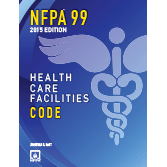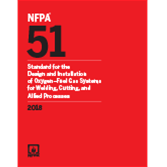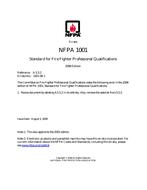Codes and standards published by NFPA are displayed as read-only under license from NFPA solely for use within this system. NFPA material may not be downloaded, printed, reproduced, or transferred.
Apply NFPA 484, Standard for Combustible Metals, to help ensure that you meet the most advanced fire and explosion safety requirements related to combustible metals and metal dusts.
NFPA 484, Standard for Combustible Metals, was developed in response to fires where fire suppression water was used inappropriately, often with disastrous results. The standard includes widely accepted safety requirements for any metal that meets its definition of a combustible metal, including alkali metals, aluminum, hafnium, magnesium, niobium, tantalum, titanium, and zirconium. NFPA 484, Standard for Combustible Metals, addresses the production, processing, finishing, handling, storage, use, and recycling of all metals and alloys that are in a form capable of combustion or explosion.
Make sure you understand and follow the requirements for proper dust collection, housekeeping, and identification of potential ignition sources.
It’s important to understand that fire and explosion hazards might be present due to operations involving the production, processing, finishing, handling, recycling, storage, and use of all metals and alloys that are in a form that is capable of combustion or explosion. Operations where metal or metal alloys are subjected to processing or finishing operations that can produce combustible powder or dust are also covered by this standard.
Changes throughout the 2022 edition of NFPA 484, Standard for Combustible Metals, can help you apply the standard correctly in different work environments.
This edition of the standard has been reorganized so that the first nine chapters correlate with the topics covered in NFPA 652, Standard on the Fundamentals of Combustible Dust, as well as to organize the remaining chapters to ensure the first nine chapters do not conflict with other sections of the standard. Chapter 13, Additive Manufacturing, was also revised to address the following:
- The growing utilization of metal powders in additive manufacturing
- Dust hazard analysis
- Location of emergency shutdown controls
- Harvesting printed objects
- Powder storage
- Operator training
Further updates for the 2022 edition of NFPA 484, Standard for Combustible Metals, include the following:
- A new requirement for the Kst value to be doubled for certain metals – unless their explosibility characteristics are determined in a 1 m3 or larger test vessel – has been added, in addition to annex material to help explain this requirement.
- The requirements for fire detection for dry-type air-material separators have been revised to allow for the use of methods other than surface-mounted devices and to require that all filter locations (if present) be monitored.
- Chapter 15, Legacy Metals, has been reorganized to consolidate the requirements that apply to all legacy metals.
Everyone involved with facility fire safety or fire prevention and protection where combustible metals and combustible metal dusts are present needs to use the latest edition of NFPA 484, Standard for Combustible Metals. Order your copy of the 2022 edition today. (Print, Approx. 158 pp., 2022)
Product Details
- Published:
- 09/15/2021
- Number of Pages:
- 160


